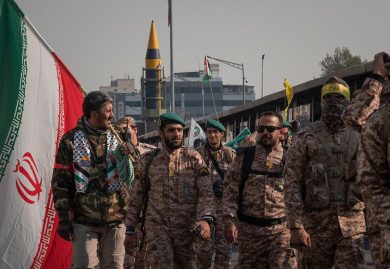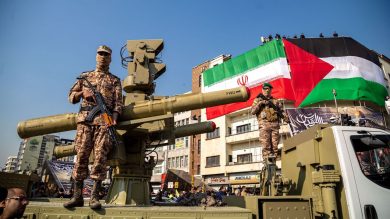The Islamic Revolutionary Guard Corps (IRGC), the most powerful force in Iran’s authoritarian regime, has consistently viewed women leaders, activists, and journalists as a direct threat to its rule. From the mandatory hijab laws to the violent suppression of female-led protests, the IRGC has long relied on fear, arrests, and intimidation to silence women.
But why does the IRGC fear women so much? Why does the regime target female activists with such brutality? The answer lies in women’s power to inspire change, mobilize resistance, and challenge the very foundation of the regime’s ideology.
This analysis explores:
• The ideological reasons behind the IRGC’s fear of women.
• How women’s leadership threatens the regime’s control.
• The tactics the IRGC uses to suppress female leaders.
• How Iranian women continue to resist despite brutal repression.
• The role of global solidarity in protecting and amplifying their voices.
1. Why the IRGC Fears Women’s Leadership
A. Women Challenge the Foundation of the Regime
The Islamic Republic was built on strict gender roles and male-dominated control. Women who speak out, organize protests, and defy dress codes are not just challenging individual laws—they are challenging the very legitimacy of the regime.
How Women’s Leadership Threatens the IRGC:
• Symbolic Defiance: A woman removing her hijab in public is a direct rejection of the regime’s ideology.
• Political Mobilization: Women have played a key role in every major Iranian uprising.
• Cross-Class and Cross-Ethnic Influence: Women’s movements unite various social and ethnic groups, making them harder to suppress.
In short, Iranian women are leading the revolution—and the IRGC knows this.
B. Women Are Key to Mass Mobilization
Women’s leadership has been instrumental in organizing protests, strikes, and resistance movements. Unlike traditional opposition groups, women-led movements:
• Cross political and ideological divides, uniting secular and religious Iranians.
• Bring international attention to Iran’s human rights abuses.
• Use digital activism to counter IRGC propaganda.
By suppressing female leaders, the IRGC hopes to cut off the head of the resistance.
2. Tactics the IRGC Uses to Silence Women Leaders
A. Targeted Arrests and Imprisonment
The IRGC routinely arrests women activists, journalists, and lawyers, often on fabricated charges like:
• “Spreading propaganda against the state.”
• “Acting against national security.”
• “Encouraging moral corruption.”
Many women face long prison sentences, often in notorious prisons like Evin and Qarchak, where they endure:
• Torture and sexual violence.
• Solitary confinement for months.
• Denial of medical care.
Despite these horrors, many women continue their activism from inside prison.
B. Public Humiliation and Forced Confessions
The IRGC uses public shaming tactics to break women’s spirits, including:
• Forcing televised confessions under torture.
• Fabricating charges of espionage to discredit activists.
• Threatening family members to create fear.
This strategy aims to discourage others from following in their footsteps.
C. Digital Surveillance and Cyber Attacks
Iranian women have turned social media into a weapon of resistance, forcing the IRGC to respond with:
• Mass internet shutdowns during protests.
• Online harassment campaigns against female activists.
• Hacking and doxxing of dissidents abroad.
Despite these efforts, Iranian women continue to outmaneuver the IRGC online.
D. Sexual Violence as a Tool of Repression
Numerous reports detail sexual violence against female detainees, a deliberate tactic to:
• Break their spirit and force them into silence.
• Shame them publicly, especially in conservative families.
• Send a warning to other women who might resist.
This brutal practice highlights the depth of the IRGC’s fear—because if women’s voices didn’t matter, they wouldn’t go to such extremes to silence them.
3. How Iranian Women Continue to Resist
A. Women Leading the “Women, Life, Freedom” Movement
The “Women, Life, Freedom” movement, ignited by Mahsa Amini’s death, has become a global movement. Women are:
• Protesting in the streets, burning their hijabs in defiance.
• Recording and sharing abuses despite digital repression.
• Using art, music, and literature as forms of resistance.
They refuse to back down, proving that fear will not win.
B. Imprisoned but Not Broken: Women Activists Fighting from Behind Bars
Even behind bars, women like Narges Mohammadi and Nasrin Sotoudeh continue to:
• Expose human rights abuses through letters and secret communications.
• Inspire international campaigns demanding their release.
• Strengthen the global movement for Iranian women’s rights.
The IRGC may imprison their bodies, but they cannot imprison their spirit.
4. The Role of Global Solidarity in Supporting Women Leaders
A. Designating the IRGC as a Terrorist Organization
• The United States has already designated the IRGC as a terrorist group due to its human rights abuses and violent suppression.
• Europe and other nations must follow to:
✔ Isolate the IRGC economically and politically.
✔ Send a message that gender-based oppression will not be tolerated.
B. Targeted Sanctions on Human Rights Violators
Governments should impose sanctions on individual IRGC leaders responsible for:
• Gender-based repression.
• Arrests and torture of female activists.
• Censorship and digital crackdowns.
These measures can increase pressure on the regime and protect women at risk.
C. Amplifying Women’s Voices Internationally
• Media outlets must continue covering Iranian women’s resistance.
• Social media users should share stories of imprisoned activists.
• Universities and NGOs should offer fellowships to Iranian women leaders in exile.
The world must not let their sacrifices go unnoticed.
D. Providing Digital and Legal Protection
• Tech companies should ensure access to secure communication tools for activists.
• Legal organizations must push for international human rights cases against the IRGC.
• Humanitarian groups should support asylum and relocation programs for women fleeing persecution.
These actions can help protect Iranian women leaders from IRGC retaliation.
Conclusion: Women’s Leadership is the IRGC’s Greatest Fear
The IRGC fears women because they represent a future where oppression no longer rules. Women’s resistance threatens the regime’s foundation, proving that authoritarianism cannot survive in the face of collective courage.
Join Our Newsletter!
Stay informed with the latest updates, news, and ways to take action in the fight for justice and global security. Sign up now to get updates delivered straight to your inbox!





